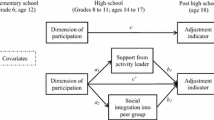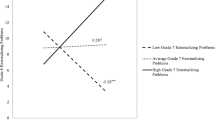Abstract
The current cross-sectional study investigated the links between various dimensions of organized activity involvement and depressive symptoms, loneliness, and peer victimization in an ethnically and economically diverse sample of adolescents (N = 152; 58% female). Results indicate that adolescents who were involved in organized activities for more years also reported lower levels of loneliness. There was evidence of diminishing returns when adolescents were very highly involved in organized activities; those who were either under- or over-involved reported the highest levels of depressive symptoms. Conversely, findings indicate that adolescents who participated in a narrow or wide range of activity contexts reported the lowest levels of depressive symptoms. In addition, results suggested that the relation between organized activity involvement and adjustment differs among adolescents from diverse ethnic and socioeconomic backgrounds. Findings from the current study also underscore the importance of considering multiple indices of activity involvement when assessing its association with adjustment.




Similar content being viewed by others
References
Aiken, L. S., & West, S. G. (1991). Multiple regression: Testing and interpreting interactions. Thousand Oaks, CA: Sage Publications, Inc.
Andersen, S. L., & Teicher, M. H. (2008). Stress, sensitive periods and maturation events in adolescent depression. Trends in Neurosciences, 31(4), 183–191. doi:10.1016/j.tins.2008.01.004.
Asher, S. R., & Wheeler, V. A. (1985). Children’s loneliness: A comparison of rejected and neglected peer status. Journal of Consulting and Clinical Psychology, 52, 500–505. doi:10.1037/0022-006X.53.4.500.
American Psychological Association, Task Force on Socioeconomic Status. (2007). Report of the APA task force on socioeconomic status. Washington, DC: American Psychological Association.
Barber, B. L., Eccles, J. S., & Stone, M. R. (2001). Whatever happened to the jock, the brain, and the princess? Young adult pathways linked to adolescent activity involvement and social identity. Journal of Adolescent Research, 16, 429–455. doi:10.1177/0743558401165002.
Bartko, W. T., & Eccles, J. S. (2003). Adolescent participation in structured and unstructured activities: A person-oriented analysis. Journal of Youth and Adolescence, 32, 233–241. doi:10.1023/A:1023056425648.
Bohnert, A. M., Aikins, J. W., & Edidin, J. (2007). The role of organized activities in facilitating social adaptation across the transition to college. Journal of Adolescent Research, 22, 1–20. doi:10.1177/0743558406297940.
Bohnert, A. M., & Garber, J. (2007). Prospective relations between organized activity participation and psychopathology during adolescence. Journal of Abnormal Child Psychology, 35, 1021–1033. doi:10.1007/s10802-007-9152-1.
Bohnert, A. M., Kane, P., & Garber, J. (2008). Organized activity participation and internalizing and externalizing symptoms: Reciprocal relations during adolescence. Journal of Youth and Adolescence, 37, 239–250. doi:10.1007/s10964-007-9195-1.
Busseri, M. A., Rose-Krasnor, L., Willoughby, T., & Chalmers, H. (2006). A longitudinal examination of breadth and intensity of youth activity involvement and successful development. Developmental Psychology, 42, 1313–1326. doi:10.1037/0012-1649.42.6.1313.
Crick, N. R., & Ladd, G. (1993). Children’s perceptions of their peer experiences: Attributions, loneliness, social anxiety, and social avoidance. Developmental Psychology, 29, 244–254. doi:10.1037/0012-1649.29.2.244.
Darling, N. (2005). Participation in extracurricular activities and adolescent adjustment: Cross-sectional and longitudinal findings. Journal of Youth and Adolescence, 34, 493–505. doi:10.1007/s10964-005-7266-8.
Dworkin, J. B., Larson, R., & Hansen, D. (2003). Adolescents’ accounts of growth experiences in youth activities. Journal of Youth and Adolescence, 32, 17–26. doi:10.1023/A:1021076222321.
Eccles, J. S., & Barber, B. L. (1999). Student council, volunteering, basketball, or marching band: What kind of extracurricular involvement matters? Journal of Adolescent Research, 14, 10–43. doi:10.1177/0743558499141003.
Eccles, J. S., Barber, B. L., Stone, M., & Hunt, J. (2003). Extracurricular activities and adolescent development. The Journal of Social Issues, 59, 865–889. doi:10.1046/j.0022-4537.2003.00095.x.
Entwisle, D. R., & Astone, N. M. (1994). Some practical guidelines for measuring youth’s race/ethnicity and socioeconomic status. Child Development, 65, 1521–1540. doi:10.2307/1131278.
Fletcher, A. C., Nickerson, P., & Wright, K. L. (2003). Structured leisure activities in middle childhood: Links to well-being. Journal of Community Psychology, 31, 641–659. doi:10.1002/jcop.10075.
Fredricks, J. A., & Eccles, J. S. (2006a). Extracurricular involvement and adolescent adjustment: Impact of duration, number of activities, and breadth of participation. Applied Developmental Science, 10, 132–146. doi:10.1207/s1532480xads1003_3.
Fredricks, J. A., & Eccles, J. S. (2006b). Is extracurricular participation associated with beneficial outcomes? Concurrent and longitudinal relations. Developmental Psychology, 42, 698–713. doi:10.1037/0012-1649.42.4.698.
Garber, J. (1984). The developmental progression of depression in female children. In D. Cicchetti & K. Schneider-Rosen (Eds.), New directions for child development (pp. 25–58). San Francisco: Jossey-Bass.
Garber, J., Keiley, M. K., & Martin, N. C. (2002). Developmental trajectories of adolescents’ depressive symptoms: Predictors of change. Journal of Consulting and Clinical Psychology, 70, 79–95. doi:10.1037/0022-006X.70.1.79.
Hanish, L. D., & Guerra, N. G. (2000). Predictors of peer victimization among urban youth. Social Development, 9, 521–543. doi:10.1111/1467-9507.00141.
Hintze, J. (2006). NCSS, PASS, and GESS: Statistical and power analysis software. Kayesville, UT: Number Cruncher Statistical Systems.
Holmbeck, G. N. (2002). Post-hoc probing of significant moderational and mediational effects in studies of pediatric populations. Journal of Pediatric Psychology, 27, 87–96. doi:10.1093/jpepsy/27.1.87.
Horowitz, J. L., & Garber, J. (2006). The prevention of depressive symptoms in children and adolescents: A meta-analytic review. Journal of Consulting and Clinical Psychology, 74, 401–415. doi:10.1037/0022-006X.74.3.401.
Jacobs, J. E., Vernon, M. K., & Eccles, J. (2005). Activity choices in middle childhood: The roles of gender, self-beliefs, and parents’ influence. In J. L. Mahoney & R. W. Larson (Eds.), Organized activities as contexts of development: Extracurricular activities, after-school and community programs (pp. 235–254). Mahwah, NJ: Erlbaum.
Kao, G., Tienda, M., & Schneider, B. (1996). Racial and ethnic variation in academic performance. In A. M. Pallas (Ed.), Research in sociology of education and socialization (pp. 263–297). Greenwich, CT: JAI Press.
Kinney, D. A. (1993). From nerds to normals: The recovery of identity among adolescents from middle school to high school. Sociology of Education, 66, 21–40. doi:10.2307/2112783.
Kovacs, M. (1981). Rating scales to assess depression in school-aged children. Acta Paedopsychiatrica, 46, 305–315.
Larson, R. W., Hansen, D. M., & Moneta, G. (2006). Differing profiles of developmental experiences across types of organized youth activities. Developmental Psychology, 42, 849–863. doi:10.1037/0012-1649.42.5.849.
Lerner, R. M., Freund, A. M., De Stefanis, I., & Habermas, T. H. (2001). Understanding developmental regulation in adolescence: The use of the selection, optimization, and compensation model. Human Development, 44, 29–50. doi:10.1159/000057039.
Luthar, S. S., & Becker, B. E. (2002). Privileged but pressured? A study of affluent youth. Child Development, 73, 1593–1610. doi:10.1111/1467-8624.00492.
Luthar, S. S., Shoum, K. A., & Brown, P. J. (2006). Extracurricular involvement among affluent youth: A scapegoat for “ubiquitous achievement pressures”? Developmental Psychology, 42, 583–597. doi:10.1037/0012-1649.42.3.583.
Mahon, N. E., Yarcheski, A., Yarcheski, T. J., Cannella, B. L., & Hanks, M. M. (2006). A meta-analytic study of predictors for loneliness during adolescence. Nursing Research, 55, 308–315. doi:10.1097/00006199-200609000-00003.
Mahoney, J. L. (2000). School extracurricular activity participation as a moderator in the development of antisocial patterns. Child Development, 71, 502–516. doi:10.1111/1467-8624.00160.
Mahoney, J. L., Cairns, B. D., & Farmer, T. W. (2003). Promoting interpersonal competence and educational success through extracurricular activity participation. Journal of Educational Psychology, 95, 409–418. doi:10.1037/0022-0663.95.2.409.
Mahoney, J. L., Harris, A. L., & Eccles, J. S. (2006). Organized activity participation, positive youth development, and the over-scheduling hypothesis (Social Policy Report No. 4). Ann Arbor, MI: Society for Research in Child Development.
Mahoney, J. L., Larson, R. W., Eccles, J. S., & Lord, H. (2005). Organized activities as developmental contexts for children and adolescents. In J. L. Mahoney, R. W. Larson, & J. S. Eccles (Eds.), Organized activities as contexts of development: Extracurricular activities, after-school and community programs (pp. 3–22). Mahwah, New Jersey: Lawrence Erbaum Associates.
Mahoney, J. L., Schweder, A. E., & Stattin, H. (2002). Structured after-school activities as a moderator of depressed mood for adolescents with detached relations to their parents. Journal of Community Psychology, 30, 69–86. doi:10.1002/jcop.1051.
Markstrom, C. A., Li, X., Blackshire, S. L., & Wilfong, J. J. (2005). Ego strength development of adolescents involved in adult-sponsored structured activities. Journal of Youth and Adolescence, 34, 85–95. doi:10.1007/s10964-005-3208-8.
Marsh, H. W. (1992). Extracurricular activities: Beneficial extension of the traditional curriculum or subversion of academic goals? Journal of Educational Psychology, 84, 553–562. doi:10.1037/0022-0663.84.4.553.
Marsh, H. W., & Kleitman, S. (2002). Extracurricular school activities: The good, the bad, and the nonlinear. Educational Review, 72, 464–514.
McHale, S. M., Crouter, A. C., & Tucker, C. J. (2001). Free-time activities in middle childhood: Links with adjustment in early adolescence. Child Development, 72, 1764–1778. doi:10.1111/1467-8624.00377.
Pedersen, S., & Seidman, E. (2005). Contexts and correlates of out-of-school activity participation among low-income urban adolescents. In J. L. Mahoney, R. Larson, & J. S. Eccles (Eds.), Organized activities as contexts of development: Extracurricular activities, after-school and community programs (pp. 85–109). Mahwah, NJ: Lawrence Erbaum Associates Publishers.
Peng, S. S., & Wright, D. (1994). Explanation of academic achievement of Asian American students. The Journal of Educational Research, 87, 346–352.
Posner, J. K., & Vandell, D. L. (1999). After-school activities and the development of low-income urban children: A longitudinal study. Developmental Psychology, 35, 868–879. doi:10.1037/0012-1649.35.3.868.
Powell, D. R., Peet, S. H., & Peet, C. E. (2002). Low-income children’s academic achievement and participation in out-of-school activities in 1st grade. Journal of Research in Childhood Education, 16, 202–211.
Prinstein, M. J., Boergers, J., & Vernberg, E. M. (2001). Overt and relational aggression in adolescents: Social-psychological adjustment of aggressors and victims. Journal of Clinical Child Psychology, 30, 479–491. doi:10.1207/S15374424JCCP3004_05.
Rose-Krasnor, L., Busseri, M. A., Willoughby, T., & Chalmers, H. (2006). Breadth and intensity of youth activity involvement as contexts for positive development. Journal of Youth and Adolescence, 35, 385–399. doi:10.1007/s10964-006-9037-6.
Sandstrom, M. J., & Coie, J. D. (1999). A developmental perspective on peer rejection: Mechanisms of stability and change. Child Development, 70, 955–966. doi:10.1111/1467-8624.00069.
Saylor, C. F., Finch, A. J., Spirito, A., & Bennet, B. (1984). The children’s depression inventory: A systematic evaluation of psychometric properties. Journal of Consulting and Clinical Psychology, 52, 955–967. doi:10.1037/0022-006X.52.6.955.
Schwartz, D., Gorman, A. H., Nakamoto, J., & McKay, T. (2006). Popularity, social acceptance, and aggression in adolescent peer groups: Links with academic performance and school attendance. Developmental Psychology, 42, 1116–1127. doi:10.1037/0012-1649.42.6.1116.
Simpkins, S. D., Fredricks, J. A., Davis-Kean, P. E., & Eccles, J. S. (2006). Healthy mind, healthy habits: The influence of activity involvement in middle childhood. In A. C. Huston & M. N. Ripke (Eds.), Developmental contexts in middle childhood: Bridges to adolescence and adulthood (pp. 283–302). New York, NY: Cambridge University Press.
Storch, E. A., & Ledley, D. (2005). Peer victimization and psychosocial adjustment in children: Current knowledge and future directions. Clinical Pediatrics, 44, 29–38. doi:10.1177/000992280504400103.
Strauss, R. S., & Pollack, H. A. (2003). Social marginalization of overweight children. Archives of Pediatrics and Adolescent Medicine, 157, 746–752. doi:10.1001/archpedi.157.8.746.
Youniss, J., McLellan, J. A., Su, Y., & Yates, M. (1999). The role of community service in identity development: Normative, unconventional, and deviant orientations. Journal of Adolescent Research, 14, 248–261. doi:10.1177/0743558499142006.
Zaff, J. F., Moore, K. A., Papillo, A. R., & Williams, S. (2003). Implication of extracurricular activity participation during adolescence on positive outcomes. Journal of Adolescent Research, 18, 599–630. doi:10.1177/0743558403254779.
Author information
Authors and Affiliations
Corresponding author
Rights and permissions
About this article
Cite this article
Randall, E.T., Bohnert, A.M. Organized Activity Involvement, Depressive Symptoms, and Social Adjustment in Adolescents: Ethnicity and Socioeconomic Status as Moderators. J Youth Adolescence 38, 1187–1198 (2009). https://doi.org/10.1007/s10964-009-9417-9
Received:
Accepted:
Published:
Issue Date:
DOI: https://doi.org/10.1007/s10964-009-9417-9




